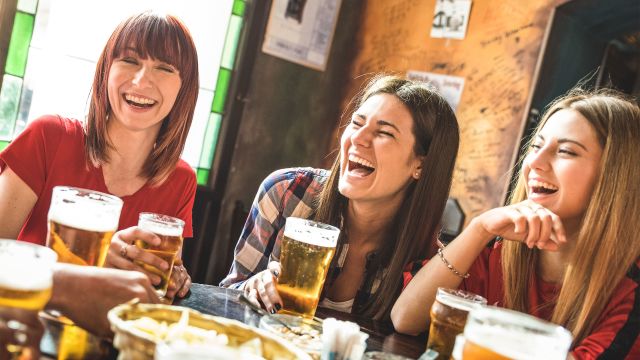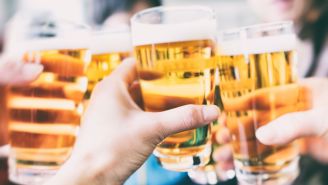Whether it’s a pint of beer at the pub or a glass of wine at the end of a long day, we often think of alcohol as a good thing. Drinking relaxes us. It opens us up and makes socializing easier. For a short time, anyway, it can help us forget our anxieties.
But to our bodies, alcohol is a toxin to be quickly and efficiently flushed from the system. If we’re unable to do that, or if we overwhelm ourselves with too much alcohol for too long, it can seriously damage our health.
Some people are more vulnerable than others, notes Patricia Molina, MD, PhD, head of the physiology department at Louisiana State University Health Services Center and director of the Alcohol and Drug Abuse Center of Excellence in New Orleans.
People with chronic health conditions may be at a higher risk for medical issues stemming from drinking than those who are completely healthy, but even healthy people should be careful, explains Dr. Molina. “There is always a risk that genetics and family history of alcohol use disorders can be lurking in the background,” she says.
So, what is alcohol, exactly? What happens in your body when you drink? How can it affect your health, immediately, and in the years to come?
Here’s what you should know.
Booze basics
The type of alcohol in drinks is called ethanol. It’s a byproduct of fermentation, a chemical process in which yeast breaks down sugars. You can make alcohol from a variety of plants, likes grapes or barley, and it’s found in beer, wine, liquor and malt liquor.
In the US, there are 0.6 fluid ounces of alcohol in your standard drink. As a rule of thumb, that’s about the amount found in:
- 12 ounces (one can) of beer of about 5 percent alcohol
- 8-9 ounces of malt liquor of about 7 percent alcohol
- 5 ounces of wine of about 12 percent alcohol
- 1.5 ounces of spirits (vodka, rum, etc.) of about 40 percent (or 80-proof) alcohol
For women, moderate drinking is defined as having up to one of these daily; for men, it’s up to two. More than that is considered heavy drinking.
It’s worth noting that when guidelines say one drink per day, they mean just that—drinks consumed in a single day—rather than an average over several days. In other words, you can’t have seven drinks on Friday and none the rest of the week and say you’re drinking “moderately.”
Throwing back multiple drinks in one sitting—for women, four or more, and for men, five or more—is known as binge drinking. In 2015, a US government survey found that 26.9 percent of American adults binge drank during the previous month.
What alcohol does to your body
When you drink, alcohol is quickly absorbed by your stomach and small intestine into your bloodstream. From there, it’s transported to your liver, which is primarily responsible for breaking down the booze, and then throughout your body.
The liver’s work on alcohol follows two very simple steps, says Molina. “The first step is the conversion of alcohol to acetaldehyde.” The second step is converting that acetaldehyde—a toxic chemical—to harmless acetic acid.
On average, your liver can handle about one alcoholic beverage every 60 minutes. If you drink faster than that, your blood alcohol concentration (BAC) rises and you become intoxicated. The higher your BAC, the more drunk you are.
The rate at which BAC climbs differs from person to person and depends on the type of alcohol you drink, how fast it’s consumed and whether it’s accompanied by food. A few other factors will come into play, including your:
- Age, sex and ethnicity
- Body weight and physical condition
- Tolerance for alcohol
- Existing health issues or medications
To put things into perspective, when you start drinking, your BAC may be as low as 0.02 percent. You may just feel relaxed, happy and warm, but even at this point, your judgment is affected, and you’re more likely to do things you wouldn’t normally do.
If you keep drinking and your BAC reaches 0.08 percent or higher, you’re now too drunk to legally drive in most states. If you keep going, your BAC will continue to climb. A BAC of 0.15 percent is considered very high and will make walking and talking very difficult. At this level, and as BAC continues rising above it, the risk of vomiting, gagging, serious unintentional injuries and blackouts increases.
Why does this happen? As your BAC goes up, certain responses are triggered in your body. For example, your kidneys create more urine, which can make you go to the bathroom more often and possibly lead to dehydration. Your blood sugar levels may drop, resulting in dizziness and fatigue. Your stomach also produces excess acid, which is why you may feel nauseated or vomit.
Intoxication also upsets your nervous system. This is why you may slur your speech, lose your balance and have trouble concentrating and following conversations. Molina notes that these effects are often the easiest to identify.
If you drink excessively and your BAC reaches 0.3 to 0.4 percent or higher, you may develop alcohol poisoning, a medical emergency that requires immediate treatment. At this point, your breathing and heart rate could slow significantly and your body temperature could drop. You might have seizures, experience brain damage, fall into a coma or die. If you’ve been taking depressant drugs, like barbiturates, it increases your risk.
How alcohol causes hangovers
Hangovers typically occur after you’ve had too much to drink. Headaches, lethargy, nausea and hypersensitivity to light are common symptoms, as are perspiration, tremors and diarrhea.
“Not everybody experiences a hangover,” says Molina, and no two are exactly alike. You could be woozy for a few hours, or you could spend the entire day vomiting in a corner.
Hangovers happen for a few different reasons. They may involve the direct effects that alcohol has on your body—things like dehydration, stomach irritation and lowered levels of blood sugar. Drinking to excess also disrupts sleep cycles, messing with your biological rhythm and robbing you of a good night’s rest.
Hangovers also depend on the volume of alcohol consumed, along with the contents of the drinks themselves. Substances called congeners, produced during the fermentation process, give beverages distinctive characteristics like color and taste. Some studies show that drinks with a lot of congeners (tequila, red wine, etc.) are worse for hangovers than those low in congeners (vodka, rum, etc.).
Another factor: whether you smoked or used drugs at the same time you were drinking. Smoking cigarettes, for example, may exacerbate hangovers, possibly due to the effect of nicotine or other smoke constituents on the brain.
“Genetics and family history—how the people in that family respond to alcohol—can also contribute,” adds Molina. This includes your ability to metabolize acetaldehyde, the toxic substance converted by your liver to acetic acid.
The risks of alcohol
In terms of your health, alcohol use—especially heavy drinking or binge drinking—can cause problems immediately and down the line.
In the short-term, it may lead to injuries and accidents, such as falls and car accidents. It can impair your judgment, contributing to violence, risky sexual conduct or self-harm. Alcohol poisoning is a risk during a drinking binge, as well. You could also become ill, since getting drunk—both in the short term and regularly—can weaken your immune system.
In the long-term, alcohol damages your organs and tissues, affecting your health in a multitude of ways. It’s directly linked to a host of chronic health conditions, including heart disease, liver problems, digestive ailments and dementia. It increases your risk of breast, liver and colorectal cancer, as well as cancers of the head and neck. In fact, an estimated 3.5 percent of cancer deaths in the US are linked to alcohol.
“It can also contribute to depression or anxiety,” says Molina. “Frequently, people say, ‘Oh, a drink is going to calm me down.’” But the relief is short-lived, she notes, and many people end up increasing their alcohol intake to achieve the same effects.
There are day-to-day drawbacks of heavy drinking, too, like work and relationship conflicts, along with money problems and even encounters with the law.
Do I need to stop drinking?
Though moderate drinking is manageable for lots of people, many experts believe the ideal amount of alcohol is none at all.
So, if you don’t drink, it’s best not to start. And if you do, keep it to a minimum and be mindful about portion control. Steer clear of binge drinking and stay at or below the recommended limit—one alcoholic beverage per day for women, two for men. Speak to your healthcare provider for guidance, especially if you have a health condition or are on medication that might affect how much you can safely drink. The Sharecare app (available for iOS and Android) can also help you track your alcohol intake.
“Knowing the amount of alcohol that you are consuming, knowing the pace at which you’re drinking alcohol, knowing what your overall health status is before you engage in drinking is critical,” Molina cautions.
When it comes to alcohol and your health: less is more.






